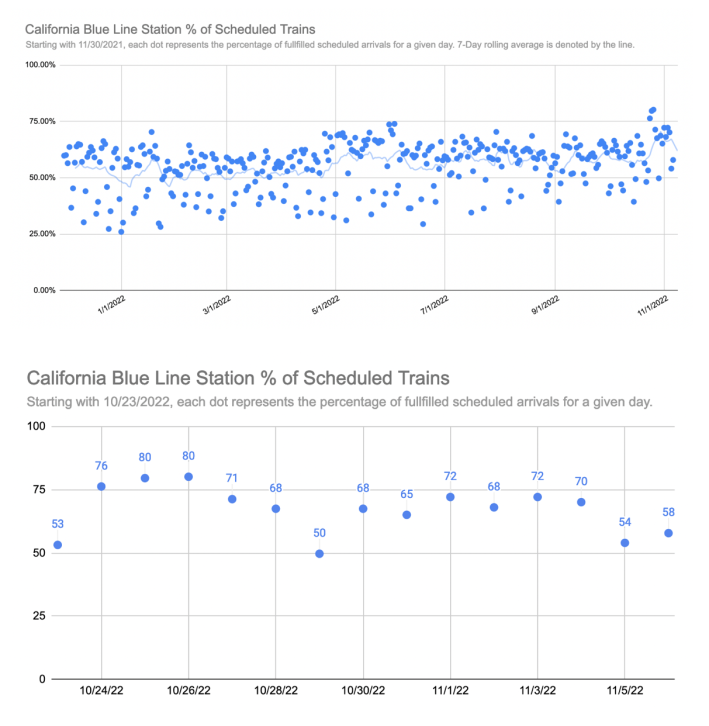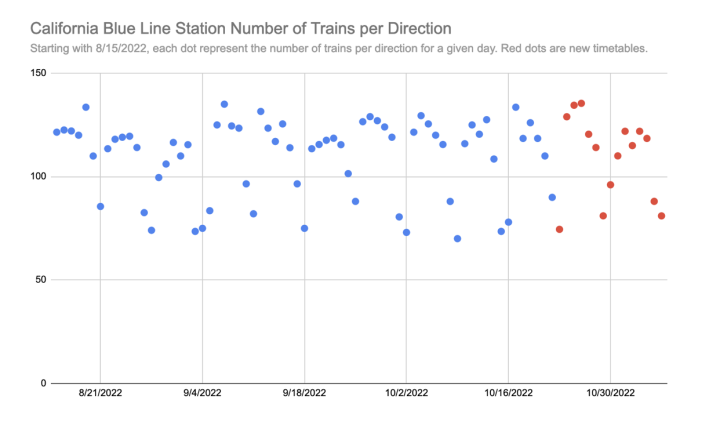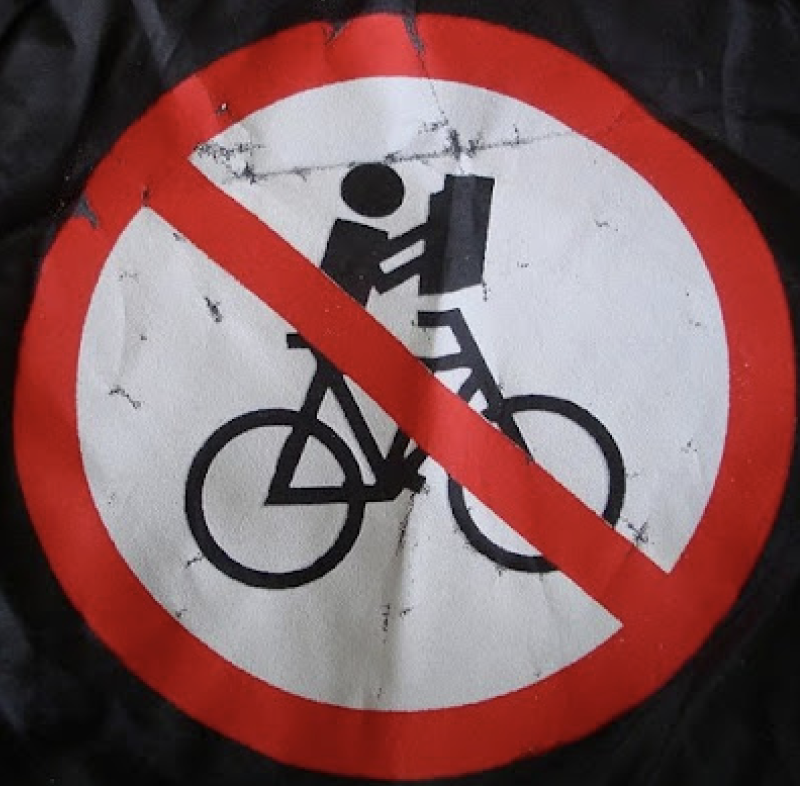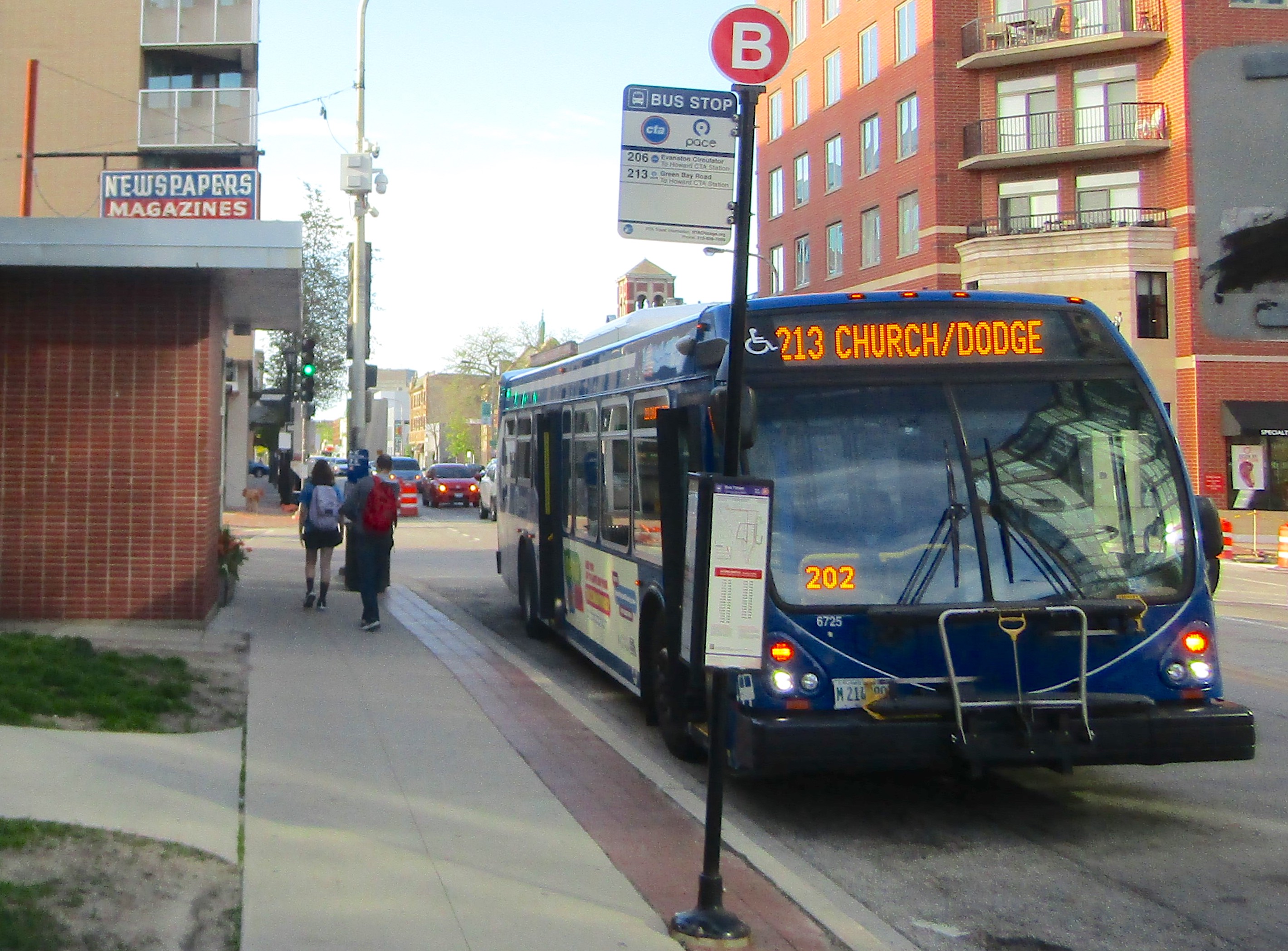Updated CTA ‘L’ schedules fail to deliver on “Meeting the Moment” promises
12:38 AM CST on November 8, 2022

The Logan Square Blue Line station. Photo: John Greenfield
Over the past two years, CTA riders have been experiencing the pain of service reductions and what have now become known as “ghost” buses and trains. Planning trips around the city of Chicago has become a gamble–one never knows whether they’ll arrive on time or be 30 minutes late due to being “ghosted” by CTA services. If I had to rate the attributes of a transit system in order of importance, predictability is at the top of the list, but currently, the CTA is anything but.
I must admit that I do not envy the conundrum the agency is currently experiencing. The perfect storm of the coronavirus pandemic, labor shortage, inflation, and high energy prices has presented a number of new challenges to transit systems nationwide. Early in the pandemic, the CTA made the decision to continue to run its full scheduled service. While commendable early on, unfortunately, the agency has been unable to adapt its practices as labor availability decreased. Throughout 2021, the CTA continued to reiterate its stance on not cutting service, despite riders experiencing a very different reality.
Looking at the state of the L service throughout 2022, riders were left in a dire situation. Based on the data I collected, the blue line was fulfilling only about half of its scheduled services. Other rail lines didn’t fare much better–another analysis found the L to only dispatch between 55 percent and 75 percent of its service throughout the summer. After increasing public pressure for more frequent and safer services, CTA unveiled its “Meeting the Moment” plan in August 2022. Among other improvements, the initiative promised that the “CTA is also improving schedules immediately to match the available workforce.” A late acknowledgment is better than no acknowledgment, I suppose. The new set of updated rail schedules was put into effect on October 23, 2022, and I was excited to once again be able to accurately predict my transit trips. Now I know my expectations were naive; the CTA is still the same old impenetrable fortress that doesn’t put their passengers, nor employees, first.

As the blue line is my own primary mode of travel, it is the focus of my analysis. The first worrying sign came when looking at the new timetable–the scheduled service reduction was only 12 percent, despite the CTA being unable to provide anywhere near that level of service all year. After the first two weeks of new timetables, the best the CTA could provide was 80 percent service. The first two Saturdays of the new schedules gave us a disappointing yet expected 49 percent and 54 percent of service.
In its obfuscated communications with the public, the CTA would like us to believe it’s making progress on its hiring efforts to bring staff levels to pre-pandemic levels. Schedules aside, if we compare the total number of trains seen each day, there’s very little, if any, upward trend. Throughout 2022, the blue line would usually see 110–135 trains in each direction per weekday, with June 3rd, 2022, being the record-breaking outlier of 144 trains. This trend has not changed, and we’re still far from full service of almost 200 daily trains.

Many Chicagoans rely on the blue line for their downtown, Monday through Friday, 9 to 5 commute. Prior to the pandemic, one could count on trains coming every 3 minutes. Trains were often crowded, but the wait for a follower would usually not be long. Two years later, the overcrowded trains remain, giving the morning ride a sense of pre-covid normalcy. But this time, the reasons are different. The CTA would like riders to believe it’s sending blue line trains towards the Loop every 5 minutes. In reality, riders often have no choice but to wait over 10 minutes for the next train as the one at the platform is likely to already be packed like sardines.
<< embed tweet https://twitter.com/FabioG_CZ/status/1587834993535057923 here >>
Not only is the overall number of trains running low, but the CTA also can’t seem to be able to dispatch them at consistent intervals. Despite not having car traffic to worry about, L trains take inspiration from buses and suffer from train bunching problems–like the common weekend occurrence of having two trains within two minutes followed by nothing for nearly half an hour. Examining my tracking data, owl service on the blue line keeps seeing gaps between trains upwards of an hour, despite being scheduled every 15 (or occasionally 30) minutes at night.
In addition to lousy schedules, the blue line disappoints riders in other ways. The Forest Park branch (between UIC-Halstead and Forest Park terminus) continues to deteriorate, with a staggering 71% of the tracks being “slow zones” where trains have to slow down to 15–35 mph. To make matters worse, the scheduled travel time hasn’t been appropriately adjusted for this slowdown. A minor annoyance to riders, but a major one to rail operators who routinely have to work overtime. CTA has also failed to bring back overnight departures from O’Hare. Their substandard shuttle replacement is often among the first impressions that visitors get of our great city. Certainly not something that the “city that works” can be proud of.
Surely if Chicago is suffering from a myriad of issues with schedules, riders in other cities must be experiencing the same. But other transit agencies have managed to address what the CTA considers to be impossible–actually aligning schedules with the available workforce. Since Los Angeles Metro announced their latest service cuts in February 2022, they have kept their trip cancellations at or below 5%. Perhaps President Dorval R. Carter, Jr. can use his APTA (American Public Transportation Association) connections to learn this magic know-how from his L.A. counterpart.
Despite the fact that President Carter’s “…ultimate goal [is] to build back our workforce to provide the transit service our customers deserve,” we are no closer to that goal today than we were two years ago. In “Meeting the Moment,” the president promised accurate schedules and more consistent service. The new rail timetables have failed to deliver on this promise and continue maintaining the status quo. Having to cut more than 20% of scheduled service on any given day is just not acceptable. If Carter’s leadership cannot deliver on something as elementary as a schedule change, perhaps it’s time to let more qualified professionals take the helm.
Fabio Göttlicher is a Chicago transit enthusiast. A software engineer by profession, he has developed his own blue line reliability tracker to monitor CTA service cuts. He’s also an organizer with Commuters Take Action, a local movement of riders who are fed up with the lack of accountability from the CTA. To learn more and to report your late bus or train, visit ctaction.org.
Stay in touch
Sign up for our free newsletter
More from Streetsblog Chicago
Elevated Chicago’s new leader on how to build more support for equitable transit-oriented development
Recently announced as executive director Juan Sebastian Arias also shared his POV on Mayor Johnson's Cut the Tape initiative to speed up the development approval process
Since COVID, Pace ridership has fared better on major corridors and in north, northwest suburbs than in south, west ‘burbs
The suburban bus system's top five busiest routes largely maintained their ridership rankings.
Due to incredible support from readers like you, we’ve surpassed our 2023-24 fundraising goal
Once again, the generosity of walk/bike/transit boosters is fueling our reporting and advocacy.




